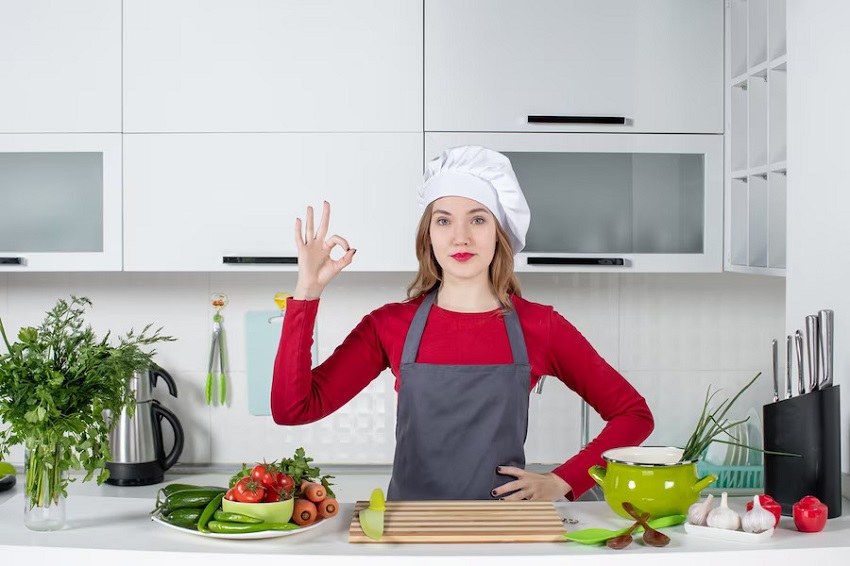What is the Basic Rule of the Kitchen

Welcome to the heart of your home – the kitchen! This is where culinary dreams take shape, where ingredients transform into mouthwatering dishes, and where memories are cooked up alongside delectable aromas. So, what exactly is the basic rule of the kitchen? Let’s dive in and explore the fundamental principles that turn cooking into an art. This content is presented by Natural-lotion.com.
Heartbeat: Love What You Do
Embrace Freshness: The Essence of Ingredients
In the realm of cooking, the kitchen’s basic rule is to embrace the freshest ingredients. Think about it – when you start with the finest produce, your dishes will shine with flavor and vibrancy. A tomato bursting with ripeness or a bunch of aromatic herbs can elevate a simple meal into a masterpiece.
Master Your Tools: From Whisks to Whetstones
Equipping your kitchen with the right tools is like a painter choosing their brushes. Knives that slice effortlessly, pans that distribute heat evenly, and spatulas that feel like extensions of your hand can make cooking a joyous experience. Kitchen hacks like using a damp paper towel to prevent lettuce from wilting or using a muffin tin to make perfectly portioned meatloaf can also make your time in the kitchen more efficient and enjoyable. Remember, a well-equipped kitchen is a chef’s playground.
Technique Matters: The Alchemy of Cooking
Technique is the secret ingredient behind every successful dish. From sautéing to simmering, mastering cooking methods is vital. Just as an artist learns brushstrokes, a cook learns the perfect flip of a pancake or the ideal browning of a steak. Each technique contributes to the symphony of flavors.
Simplicity in Complexity: Balancing Flavors
Salt, Sweet, Sour, and Umami: The Flavor Quartet
In the kitchen, flavors dance together in perfect harmony. The basic rule is to balance the core taste elements – salt for depth, sweet for delight, sour for brightness, and umami for richness. Imagine a dish as a symphony, where every note (flavor) plays its role to create a masterpiece.
The Power of Restraint: Avoid Overcomplicating
It’s easy to get carried away with intricate recipes, but simplicity often wins. Remember, even the most elegant dishes can come from just a handful of high-quality ingredients. The basic rule here is to allow the essence of each ingredient to shine, rather than overwhelming your palate.
Creativity Unleashed: Personal Touches
The Recipe as a Canvas: Dare to Innovate
Cooking is an art, and recipes are your canvas. Don’t be afraid to add your personal touches, whether it’s a dash of unexpected spice or a twist on a classic dish. Innovation in the kitchen is the key to discovering your unique culinary identity.
From Plate to Presentation: The Visual Feast
Remember, we eat with our eyes first. The presentation of a dish can transform a regular meal into a visual masterpiece. Think of your plate as a blank canvas, and the food as the paint. Garnishes, colors, and arrangement matter just as much as taste.
Respect the Process: Patience and Perseverance
Mastery Takes Time: The Slow-Cooked Wisdom
The kitchen’s basic rule of patience applies not only to the cooking time but also to your culinary journey. Just as a chef refines their skills over time, flavors deepen and meld through slow cooking. Impatience can sometimes compromise the magic that happens when ingredients simmer and meld.
Learning from “Mistakes”: Turning Oops into Opportunity
In the kitchen, as in life, mistakes happen. Burnt edges or overly salted stews might seem like disasters, but they can lead to surprising discoveries. The basic rule is to turn mishaps into opportunities for creativity. A “failed” dish can often become a new favorite with a slight twist.
Conclusion
In the realm of cooking, the basic rule of the kitchen transcends mere recipes. It’s about love, creativity, patience, and a deep connection to the process. From embracing the freshest ingredients to innovating with personal touches, the kitchen is a space where culinary magic unfolds with every sizzle, simmer, and stir.
FAQs
Q1: Can I substitute fresh herbs with dried ones?
Absolutely! While fresh herbs have a vibrant flavor, dried herbs can work well too. Just remember that dried herbs are more concentrated, so use them sparingly.
Q2: How do I rescue a dish that’s too salty?
One simple trick is to add a bit of acidity (like lemon juice or vinegar) or balance it with something sweet (like honey or sugar) to counteract the saltiness.
Q3: What’s the best way to develop knife skills?
Start with basic cuts and practice regularly. There are plenty of online tutorials that can help you refine your technique.
Q4: Why is resting meat important after cooking?
Resting allows the juices to redistribute within the meat, making it juicier and more tender when you cut into it.
Q5: How can I add umami to my dishes?
Umami-rich ingredients include mushrooms, soy sauce, fish sauce, and Parmesan cheese. Experiment with these to enhance the savory depth of your dishes.








